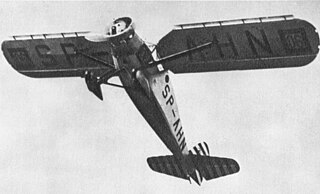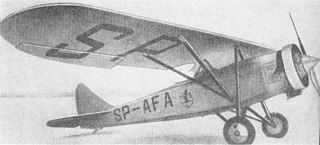
The PZL P.7 was a Polish gull wing monoplane fighter aircraft designed in the early 1930s at the PZL factory in Warsaw. It was the main fighter of the Polish Air Force between 1933 and 1935. The PZL P.7 was replaced in Polish service by its follow-up design, the PZL P.11c. More than 30 PZL P.7 fighters remained in service during the Invasion of Poland, scoring several kills despite its obsolescence.

The RWD 6 was a Polish sports plane of 1932, constructed by the RWD team. It was a winner of the Challenge 1932 international tourist aircraft contest.

The RWD 5 was a Polish touring and sports plane of 1931, a two-seat high-wing monoplane, constructed by the RWD team. It was made famous by its transatlantic flight, being the smallest aircraft to cross the Atlantic.

The RWD-10 was a Polish aerobatics sports plane, single-seat parasol wing monoplane, used from 1933 to 1939 and constructed by the RWD team.

The PZL-101 Gawron (rook) is a Polish agricultural and utility aircraft designed and built by WSK-Okęcie.

The RWD 9 was a Polish sports plane of 1934, constructed by the RWD team.

PZL.19 was a Polish sports aircraft built in 1932 in the PZL works. Ordered by the Ministry of Communications, it was specifically designed for the upcoming Challenge 1932 contest held that year in Germany.

The PZL.44 Wicher (gale) was a prototype of 14-seat, twin-engine Polish airliner, built in the Państwowe Zakłady Lotnicze (PZL) in 1938. It was to compete with the DC-2 and Lockheed Super Electra.

The PZL P.6 was a Polish fighter, designed by the engineer Zygmunt Puławski, manufactured by PZL state-owned factory. It remained a prototype.
The PZL M-24 Dromader Super is a single engine agricultural aircraft, developed in the 1980s by the WSK-Mielec from the PZL-Mielec M-18 Dromader. It did not progress beyond the prototyping stage.

The PZL-105 Flaming (flamingo) is a Polish short-takeoff-and-landing (STOL) utility aircraft designed by PZL "Warszawa-Okęcie". It remained a prototype.

The PZL-5 was a Polish two-seat touring and sports aircraft of 1930 constructed and produced by the PZL.

The MD-12 is a Polish four-engined short-range passenger and civil utility aircraft of the 1960s, which remained in the prototype stage. The PZL brand is conventional, since it did not enter production, and was referred to under its project designation only.

The PZL.43 was a Polish light bomber and reconnaissance aircraft designed in the mid-1930s by PZL in Warsaw. It was an export development of the PZL.23 Karaś. Its main user was the Bulgarian Airforce who called it the Chaika.

The PZL Ł.2 was the Polish Army cooperation and liaison aircraft, built in 1929 in the Polskie Zakłady Lotnicze (PZL) in Warsaw. Only a small series of 31 aircraft, including prototype, were made, and used by the Polish Air Force in the 1930s. The aircraft was known in Poland for accomplishing of a long-distance tour around Africa in 1931.

The Bartel BM 6 was a Polish biplane trainer fighter aircraft of 1930. It did not advance beyond the prototype stage.

The PZL P.1 was a Polish fighter, designed by the engineer Zygmunt Puławski, manufactured by the PZL state-owned factory. It remained a prototype, but it was the first of the Polish PZL gull wing fighter series, leading to the PZL P.7, PZL P.11 and PZL P.24.

The PZL.4 was a Polish three-engine passenger aircraft for 10 passengers, built in PZL factory in 1932, which remained a prototype. It was the first Polish-designed and produced multi-engine plane.

The RWD 16bis and RWD 21 were Polish two-seat low-wing touring and sports planes of the late 1930s, constructed by the RWD bureau, sharing the same construction, main difference of the RWD 21 being a stronger engine.

The PWS-5 or PWS-5t2, was a multi-seated Polish liaison aircraft, developed in 1928 by PWS.



















